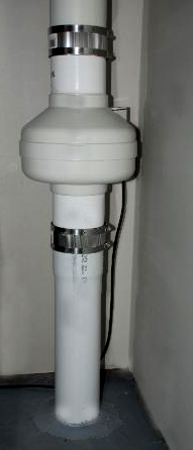HOME ARCHITECTS ® is now showing diagrammatic Radon Mitigation systems in their drawings for clients. Senior Staff Architect, Rand Soellner, ArCH, NCARB, noticed that the recent IGCC (International Green Construction Code) had a section on radon mitigation, but that it only applied to commercial buildings. This architectural firm felt that while this is a good thing to have for banks and office buildings and other public structures, house owners ought to at least have the option of deciding whether they want a radon removal system or not.
It is relatively cheap to install the basics of a radon reduction system during construction and more problematic later. So, this Architect now illustrates an optional radon reduction system in their firm’s documents and lets the owner decide whether or not they want to have it installed. The IGCC indicates the counties all over the United States and what the tendency is for radon to be a problem or not. You really never know, until you have your crawlspace or other locations in your house tested for the presence of radon.
Radon is a colorless, odorless gas emitted by soil and rocks and other materials exposed to the natural degradation of uranium underground. Lung cancer is one of the most significant risks according to the US Surgeon General. In fact, that source has indicated that radon is the 2nd leading cause of lung cancer in the United States today (approximately 21,000 people a year). Only smoking causes more cancer than radon. Radon can be found all over the USA (and other countries). It comes up from the ground and can also possibly be in well water. We encourage you to have your crawlspace, living areas and water systems checked by radon testing experts.

Testing for the presence of radon is the only way to really know for sure if your house is being exposed to radon gas or not. This may well be one of the main “mystery sources of cancer” that has plagued our population for hundreds of years. Modern society’s erection of closed buildings and homes to protect us from the weather and provide us with comfortable lifestyles has augmented the problem, because radon needs to be exhausted from the home and other buildings with a fan or multiple fans.
As the photo at left shows, an in-line fan connected to some PVC piping are part of the main components. There is also a requirement, according to the IGCC for a gravel bed under the bottom level concrete slab or crawlspace vapor barrier. The gas rises and enters this gravel bed area, then is drawn off by the fan sucking the gas up the piping and up through the structure and out the roof, much like a plumbing vent pipe.
Right now in America, this is relatively new information, only just during the last decade, but more houses that are being inspected and sold these days, have as a condition of sale that the residence be tested for radon. When radon is found, through a simple charcoal canister test (often combined with a nuclear test), a radon mitigation contractor is called in and he installs a radon reduction system, typically at the expense of the seller, prior to the real estate closing.
According to the US EPA (Environmental Protection Agency), radon reduction systems can be 99% effective in removing radon from your house. According to the EPA, the radon level should be below 4 pCi/L per this online article:
The EPA also mentions that it is less costly to have a radon reduction system installed during construction rather than after the fact.
This architectural firm wants the houses they design for you to be healthy, happy places, which is why they indicate Radon Reduction Systems as your option on all their projects.
